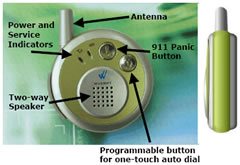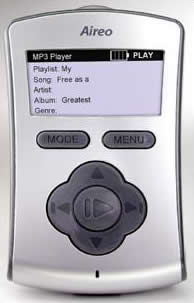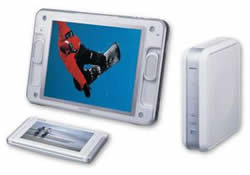Warp Records have made their music back-catalogue available for purchase online via their Bleep service, but with the twist that the tracks are not electronically protected. The bought tracks are downloaded as high quality, open MP3 files not using any form of Digital Rights Management (DRM).
We see this as an important development, as it takes a different approach to the purchaser of the music – it assumes that the majority of their customers are honest and will not pepper the file sharing networks with their paid for tracks. We will continue to monitor whether this approach has been good or bad for their sales, certainly short term they have benefited from positive press from the technically aware.
We have used the service extensively and below give an overview of the process.
_The standard – iTunes Music Store
As anyone who is attempting to sell music online is very well aware, Apple’s iTunes Music Store (iTMS) has set a high bar for other to reach, never mind exceed. iTMS addresses one of the major reasons for music copying, it brings music that people want to listen to and purchase easily within their grasp. It’s a friendly, well thought out and fast to use system, that charges an arguably reasonable amount of money, 99c, per track. The purchased tracks are downloaded in secure AAC format, can be held on up to three computers, burnt to audio CD and held on as many iPods as the track purchaser owns. iTMS licensing terms were a liberal world apart from compared to the highly restricted, effectively rental-based previous system.
_The Bleep interface
Bleep does a good job of keeping the screen uncluttered and uses three easy to follow columns that naturally progress form left to right to complete purchases. The left is for locating tracks at an album level, or for searching; the middle columns list the details tracks selected as well as enabling previewing and picking for purchase; the right hand column show the tracks ready for purchase, and following purchase, a list of tracks that can be or have been downloaded.
Selection of albums and tracks is as smooth a process as you would expect, either by clicking on the album cover icon or individual track name, if a text search has been carried out.
_Browsing & previewing tracks
Once the tracks have reached the middle column, simply clicking on Play can preview them. The previewing is quick to start, essential for a good user experience. Although it is not quite as fast as iTunes, which is like pressing track skip on a CD player, it is impressive considering it does not use a content delivery network like Akamai.
The loading of the preview track in displayed in a small, integrated Flash player, just below the album cover art, giving good feedback to the user making them aware that something is going on. Once sufficient has buffered, the first 30 seconds of the track starts playing, with a green highlight bar showing progress along the track. The preview track has been encoded at 90kbs and we found the quality more than sufficient.
There are a number of areas that Bleep wins over iTMS.
- Preview is no limited to just 30 seconds of the track – the whole track can be previewed simply by clicking the play button again, every 30 second chunk.
- Once buffered, the listener can click anywhere to the tracks timeline to listen from that point.
__Purchasing tracks
When tracks are selected for purchase, they are placed in the right hand column. A running total of the cost is displayed at the bottom of the column, as is useful additional information such as the size of download and an approximation of the time they will take to download.
Clicking on the tracks in the checkout basket the chance to still preview the tracks, you can still listen to it.
When ready to pay, the user simply clicks on the Checkout link, and they will be asked to login to their account or create an account if they have not used it before.
Warp has done a good and wise thing in making creating an account as straightforward as possible, you simply supplying your email address and a password.
The user has three way to pay; credit card, PayPal, and in the UK, mobile phone SMS text message for single tracks. After entering these relevant details, future purchases are as simple as clicking on a link.
The purchase via SMS is of particular interest as this has never been used for buying music downloads. After entering your mobile phone number in the setup screens and sending a confirmation message from you mobile to Warp, purchasing single tracks is a simple as confirming your desire to pay via SMS. An SMS is then received to the handset confirming the price charged and giving a reference number. The SMS payment option is a great idea for opening music sales to people too young to have a credit card, as they are bound to have a mobile phone.
_Receiving the booty
Once payment has been cleared, the right hand column lists the tracks now available for download. To save the trouble of downloading each track individually, there is an option to bundle them all into one Zipped file.
The user is also free to add tracks to a new shopping basket while tracking are sitting in their download list.
_Summary
Warp has done a good job with this service, generally improving on Apple’s iTMS. When comparing them it should be remember that this service is browser based, not the simpler dedicated application approach that iTMS takes.
We spoken to Warp at some length and are impressed with their understanding of the users needs. They also have some very interesting plans for the service, which we will report on when they are becoming available.
Bleep online music service
 Wherify Wireless, based in Redwood Shores California, have announced what they claim is the smallest device to contain a GPS receiver and CDMA mobile phone. It has been specifically designed to help locate people carrying it. It is very compact (48mm x 12mm), light (45 grams) and simple to use, with only two buttons to operate. One button directly alerts the emergency services, 911, giving them the location within a few feet and ability to have a conversation with owner. The second button carries out the same function but to a user programmable phone number.
Wherify Wireless, based in Redwood Shores California, have announced what they claim is the smallest device to contain a GPS receiver and CDMA mobile phone. It has been specifically designed to help locate people carrying it. It is very compact (48mm x 12mm), light (45 grams) and simple to use, with only two buttons to operate. One button directly alerts the emergency services, 911, giving them the location within a few feet and ability to have a conversation with owner. The second button carries out the same function but to a user programmable phone number. Ever since the rise of the portable digital music player people have been discussing the possibilities of connecting them wirelessly rather than via a cable, either for loading content, or playing it back. After two years development SoniqCast has now released the Element Aireo, the first product to come to market that includes 802.11b (WiFi) support.
Ever since the rise of the portable digital music player people have been discussing the possibilities of connecting them wirelessly rather than via a cable, either for loading content, or playing it back. After two years development SoniqCast has now released the Element Aireo, the first product to come to market that includes 802.11b (WiFi) support. Among the many announcements at CES was an interesting portable 12″ LCD TV screen from Sony, that can be carried around a house and have various content delivered to it from its base station, enabling the showing of video from many different sources, as well as playing music, viewing photos and browsing the Internet. Sony calls it LocationFree™.
Among the many announcements at CES was an interesting portable 12″ LCD TV screen from Sony, that can be carried around a house and have various content delivered to it from its base station, enabling the showing of video from many different sources, as well as playing music, viewing photos and browsing the Internet. Sony calls it LocationFree™.